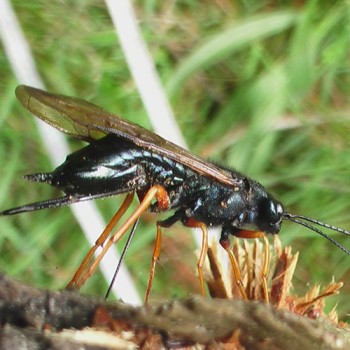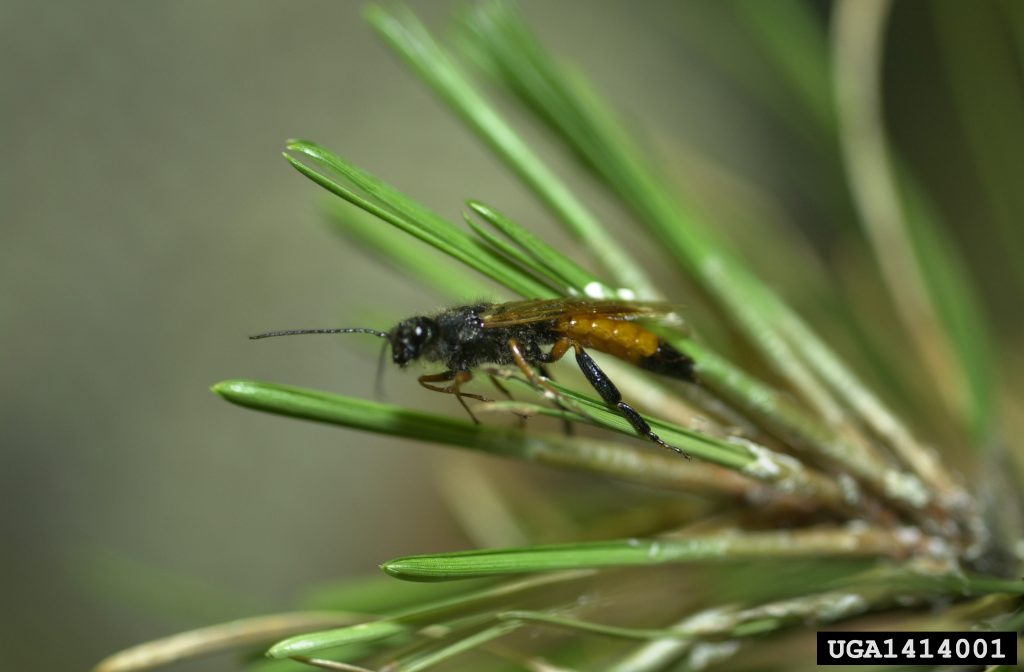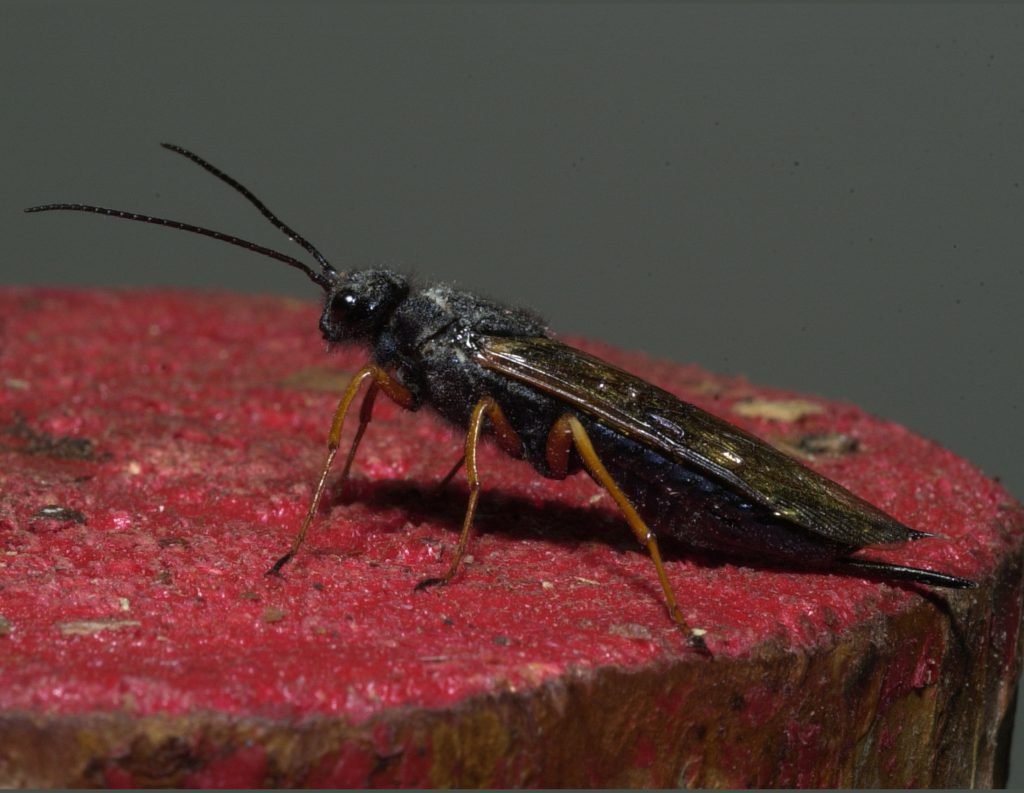Sirex Woodwasp (Sirex noctilio)
French common name: Guêpe perce-bois



Order: Hymenoptera
Family: Siricidae
The sirex woodwasp (SWW; Sirex noctilio), native to Eurasia and Africa, was likely introduced to North America through wood packing material. The first detection of SWW was in the state of New York close to Lake Ontario in 2004 (Hoebeke et al., 2005). SWW was found in Canada in 2005 (de Groot et al., 2006). The SWW is currently widespread throughout the Northeastern United States, and can be found in portions of southern Ontario and Quebec. The SWW favours scots pine (Pinus sylvestris), a non-native tree species that is widespread in northeastern North America. SWW is considered a serious threat to pine plantations as it can attack both healthy and stressed trees, although impacts have so far been limited in North America. Studies suggest that proper forest management can be effective at controlling the impacts and spread of this invasive pest.
Physical Description
Eggs: Sausage-shaped and white in colour.
Larvae: Legless and creamy to yellowish white in colour. Larvae can reach about 30 mm long and have a visible spine (needle) towards the rear end of the body.
Pupae: Initially creamy-white in colour, but gradually takes on the colour of the adult.
Adults: Dark bodies and orange legs. Males have a metallic blue head and thorax, with an orange abdomen and front legs. Females have a metallic blue head and body with orange legs. In addition, females also have a spine (needle) at the end of the abdomen. Both the male and female SWW have a cylindrical body and a pointed abdomen.
Life Cycle
The life cycle of SWW, from egg to adult, takes one to two years to be completed depending on climatic conditions. Adult SWW can be found between July and September in Quebec and southern Ontario. Female SWWs drill holes into the outer sapwood and lay eggs. Depending on its size, a female lays 25-450 eggs in its lifetime. With the eggs, the SWW injects spores of the fungus Amylostereum areolatum and a toxic mucus. The fungus and the mucus weaken the tree, aiding larval development. The larvae go through 6-12 instars, over a period of 10-11 months. The variation in the number of instars may be related to host tree suitability. Mature larvae pupate close to the surface of the bark, and adults usually emerge after three weeks. Adult SWW survive off of resources acquired as larvae, reproduce and die within 3-4 days.
Unlike native woodwasps in Canada which only attack stressed trees, the SWW also attacks healthy trees. When SWW populations are low, they tend to attack trees that are dead or dying, but attack healthy trees as their numbers increase.
Potential SWW hosts include:
- Pine species (Pinus) – main host
- Spruce (Picea)
- Fir (Abies)
- Larch (Larix)
- Douglas fir (Pseudotsuga)
Many of these potential host species occur in plantations throughout Canada, and are threatened by the SWW.
Signs and symptoms of SWW include:
- Resin dripping from oviposition sites (places on the trees where eggs are laid) mainly concentrated in the mid-bole (mid-trunk) level of the attacked tree
- Wilted foliage ranging from yellow to reddish -brown in colour.
- Larval galleries found under the bark. The galleries are usually packed with frass (insect excrement) and chewed wood.
- Round exit holes ranging between 3 and 8 mm in diameter on the bark of the tree trunk.
- Heavily infested trees usually die.
The SWW is native to Asia, Europe and Africa. It has been introduced to Canada, the U.S. as well as New Zealand, Australia, Uruguay, Argentina, Brazil, Chile, China and South Africa.
In 2005, SWW was found only in a few locations in southern Ontario but by 2010 it had expanded its range to cover almost all of southern Ontario reaching as far north as Manitoulin Island and was also in part of Quebec. In the United States, as of 2011, the SWW has been confirmed in portions of New York, Pennsylvania, Vermont, Connecticut, Ohio, and Michigan.
In Canada, the Sirex Woodwasp is federally regulated by the Canadian Food Inspection Agency (CFIA). The CFIA outlines the following policy directives pertaining to the SWW:
D-02-12 – Import requirements of non-manufactured wood and other non-propagative wood products, except solid wood packaging material, from all areas other than the continental United States
D-01-12 – Phytosanitary Requirements for the Importation and Domestic Movement of Firewood
Since SWW has been recently introduced to Canada, studies about the complex interactions among insect spread and tree mortality are ongoing. Initial studies show that the SWW prefers weak trees with a small diameter over healthy, large ones and that silvicultural treatments may be effective at managing SWW populations and minimizing its impact (Dodds, et al., 2010).
Economic impacts
Commercial industries surrounding pine trees are threatened. The mucus causes foliage to yellow and wilt while the fungus disrupts water movement; the combined effect of both the mucus and fungus often kills the host trees, depending on their condition and resistance, and assists the development of the SWW larvae (GISD, 2017). The United States Department of Agriculture Forest Service estimates that if the SWW becomes established nationwide, it would cost about $2.8 – $17 billion in lost timber and pulpwood (NYIS). A study published in 2008 by Yemshanov et al. estimated the possible physical and economic impacts of SWW on standing pine biomass in eastern Canada. The study projected medium term losses of up to $254.1 million per year after 20 years (at time of publishing) in Ontario and Quebec (Yemshanov et al., 2008).
Ecological impacts
The SWW has the potential to negatively impact wildlife, especially species that are dependent on pine trees as a habitat or food source. For example, the success of the endangered Kirtland’s warbler depends on sufficient jack pine habitat. In Michigan alone, federal and state agencies spend about $2.5 million yearly to manage jack pine stands for the endangered Kirtland’s warbler (Campbell, 2007). SWW could jeopardize this effort, and contribute to the species’ decline.
It is important to note that economic loss could vary depending on the interactions among the insect, tree mortality, and forest harvest schedule (NRCan, 2012).
Social impacts
SWW host trees in many places are an important part of the landscape’s integrity, aesthetics, and recreational value.
Detect
The currently available monitoring traps and semiochemical combinations are considered to be generally ineffective (NRCan, 2012). A study by Haavik, et al. (2014) suggests that efficacy of traps could be improved with the use of different lures. Semiochemical baited traps are known to attract SWW, but an effective combination of attractants is yet to be determined (Boroczky et al. 2009, 2012; Cooperband et al., 2012 as cited in Haavik et al., 2014).
Respond and Control
Mechanical
Silvicultural management can effectively prevent or mitigate the impacts of a SWW infestation (Dodds, et al., 2010). Silvicultural management practices such as thinning a forest to minimize overcrowding, removing weakened or dying trees, and routine surveillance have proven to be effective in mitigating the attacks of SWW in North America (Dodds at al., 2014).
Chemical
Chemical control for the SWW seems to be an option of concern due to the potential impacts on the environment and other organisms. There are currently no known effective compounds.
Biological
The parasitic nematode, Deladenus siricidicola, has been found to be a successful biological control agent for the SWW in the southern hemisphere (Texas Invasive Species Institute, 2014). The nematode sterilizes female wasps, causing them to lay infertile eggs and to spread the nematode populations wherever the eggs are laid. This nematode has been found in SWW in Canada (NRCan, 2012), but the strain is non-sterilizing in North America because it does not penetrate eggs (Yu et al. 2009 as cited in Haavik et al, 2016).
A native parasitic wasp, Ibalia leucopsoides, has been found to expand its host range to include SWW (NRCan, 2012). Studies are ongoing to identify SWW natural enemies in Canada and their effects on SWW populations.
Research
Sirex Woodwasp: A Model for Evolving Management Paradigms of Invasive Forest Pests
together constitute one of the most damaging invasive pests of pine. Despite a century of
research and well-established management programs, control remains unpredictable and …
Sirex, Surveys and Management: Challenges of having Sirex noctilio in North America
there have been intensive efforts to survey and determine the area infested and to assess
management options. In this chapter we review the history of survey efforts in Canada and …
[PDF] Identification of Sirex noctilio and native North American woodwasp larvae using DNA barcodes
northeastern US and Canada, will likely become a major pest of pines and possibly other
conifers in North America. This eurasian siricid woodwasp causes damage by the injection …
